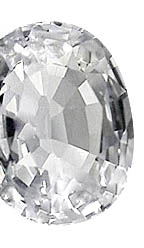
White Sapphire
The various colours throughout members from the corundum group result from small quantities of metal oxide impurities. Corundum without impurities (and for that reason without colour) is rare, however when found is classified as colourless sapphire. Stones comprised of different colours, including colourless areas, tend to be more common. Stones like these are usually orientated through the cutter so the colour reaches the bottom. Then, when viewed from above, colour fills the stone.
Truly colourless sapphire can be found in Sri Lanka. Cloudy or milky coloured sapphire can also be present in Sri Lanka, and known locally as “geuda”. Heat treating geuda produces blue sapphire, high of that is faceted and utilised in jewellery. Some Sri Lankan corundum shows red, blue and colourless areas, which can be faceted or polished to provide a fascinating stone.
Synthetic colourless corundum may be made by the Verneuil method since concerning the 1920’s, and it has been called diamondite
A white Sapphire is a colourless form of sapphire used in a wide range of jewellery as a diamond substitute. Sapphires tend to be much less expensive than diamonds, and socially conscious purchasers who are concerned about conflict diamonds can avoid political issues by purchasing sapphires instead. Most white sapphires are heat treated to obtain the desired clear colour, as it is very rare to find naturally occurring white sapphires. Some may also be chemically treated, depending on the quality of the stone and its intended use.
Sapphires are a type of aluminium oxide, which forms, in a crystalline pattern. There are numerous uses for sapphires, ranging from industrial lasers to fine jewellery, and the stones also come in a wide range of colours, despite the traditional association with the colour blue. Sapphires also come in purple, yellow, and brown, and they may have unusual properties which cause them to reflect light in a star pattern or change colour under certain lighting conditions.
There are two major sources for white sapphires. Grey to light yellow natural stones may be treated to become clear, and some companies also grow their own stones, creating synthetic sapphires which are chemically identical to the real thing. A synthetic white sapphire tends to be less expensive, because consumers perceive lab-grown gems as inferior, but it may sometimes be of better quality, thanks to the controlled growing conditions. Natural sapphires are found in Southeast Asia, the Indian subcontinent, parts of Africa, the Middle East, and in the Western states of America.
Like a diamond, a white sapphire can be cut and polished to be an extremely brilliant stone, refracting light in a bright and dynamic way. White sapphires are also extremely hard, making them almost as durable as diamonds. These two traits make white sapphires a popular diamond alternative, although sapphires may not have the same cultural value that diamonds do.
When selecting a white sapphire, look for many of the same traits that you do in a diamond. The stone should be cut in a flattering way which frees the brilliance in the stone to create a bright sparkle, and the stone should be truly clear, without clouds of any other colour. If size is an issue for you, you should also look for a large Carat white sapphire to ensure that your needs are met.

